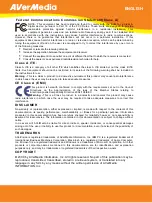
Piranha ES-Sx User Manual
Teledyne DALSA
03-032-20162-00
29
For adjacent tap 17, the mean of the first 16 pixels are gained to match the mean of the last
16 pixels of tap 16. This seam matching continues to tap 30.
Calibrating the Camera to Remove Non-Uniformity
(Flat Field Correction)
Flat Field Correction Overview
This camera has the ability to calculate correction coefficients in order to remove non-
uniformity in the image when operating in TDI Mode. This video correction operates on a
pixel-by-pixel basis and implements a two point correction for each pixel. This correction
can reduce or eliminate image distortion caused by the following factors:
•
Fixed Pattern Noise (FPN)
•
Photo Response Non Uniformity (PRNU)
Lens and light source non-uniformity Correction is implemented such that for each pixel:
V
output
=[(V
input
- dark offset- FPN ( pixel )) * digital gain * PRNU (pixel)]
where
V
output
=
digital output pixel value
V
input
=
digital input pixel value from the CCD
PRNU( pixel)
=
PRNU correction coefficient for this pixel
FPN( pixel )
=
FPN correction coefficient for this pixel
The algorithm is performed in two steps. The fixed offset (FPN) is determined first by
performing a calculation without any light. This calibration determines exactly how much
offset to subtract per pixel in order to obtain flat output when the CCD is not exposed.
The white light calibration is performed next to determine the multiplication factors
required to bring each pixel to the required value (target) for flat, white output. Video
output is set slightly above the brightest pixel (depending on offset subtracted).
Flat Field Correction Restrictions
It is important to do the FPN correction first. Results of the FPN correction are used in the
PRNU procedure. We recommend that you repeat the correction when a temperature
change greater than 10°C occurs or if you change the integration time.
PRNU correction requires a clean, white reference. The quality of this reference is
important for proper calibration. White paper is often not sufficient because the grain in
the white paper will distort the correction. White plastic or white ceramic will lead to
better balancing.
For best results, ensure that:
1.
60 Hz ambient light flicker is sufficiently low not to affect camera
performance and calibration results.
2.
The brightest pixel should be slightly below the target output.
3.
When 6.25% (or more) of pixels from a single row within the region of interest
are clipped, flat field correction results may be inaccurate.
Note: If your
illumination or white
reference does not
extend the full field of
view of the camera,
the camera will send a
warning.
















































